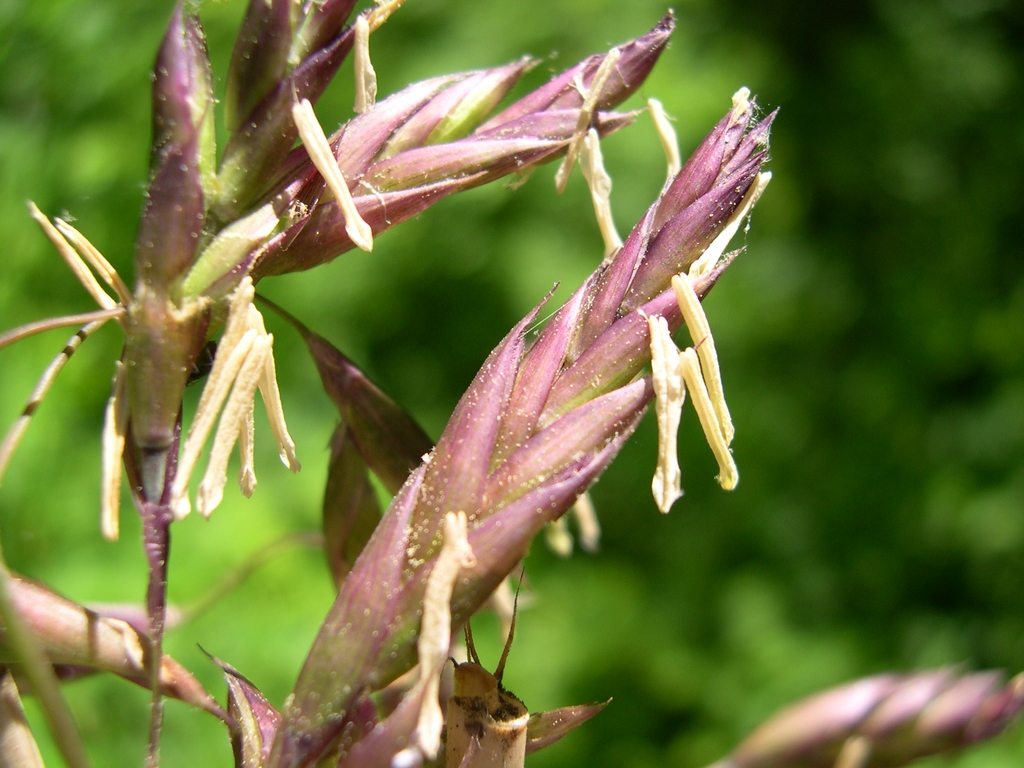Arundinaria gigantea
Common Name(s):
- Phonetic Spelling
- ar-run-din-NAY-ree-a jy-GAN-tee-uh
- Description
-
Giant cane is a native bamboo in the Poaceae (grass) family found on floodplains of medium to low-energy rivers and streams in the central and southeastern U.S.A. While it may grow up to 25 feet tall it is usually between 8 and 20 feet. It is an adaptable plant and can be found in the coastal lowland to the mountains up to 2,000 feet.
Plant in full sun to deep shade though it does best in partial to full sun in rich, loamy, well-drained soils. It can tolerate brief periods of inundation, but will not thrive in wet areas. Use this plant along streams or ponds in well-drained moist sites to stabilize banks and naturalize a wildlife area.
Giant cane has tall thin green stems and vigorous rhizomes that grow quickly into dense clumps. The leaves are alternative with mostly entire margins and a few hairs on the undersides. Flowers are inconspicuous and rare but appear in the spring and flowering stems die back when the seeds mature in the summer. The green culms are hollow with internodes and mature to brown.
This native bamboo can form a dense patch of monoculture called a canebrake providing cover and food for dozens of species of mammals and invertebrates. This includes a number of butterflies and moths requiring rivercane earning them status as "canebrake specialists." The native bamboos have been over-grazed by cattle and uprooted by swine, thus decreasing their populations along with loss of habitat.
Fire Risk: This plant has an extreme flammability rating and should not be planted within the defensible space of your home. Select plants with a low flammability rating for the sites nearest your home.
Insects, Diseases, and Other Plant Problems: No serious problems though Rust and leafspots may occur.
- See this plant in the following landscape:
- Cultivars / Varieties:
-
- Tags:






















- Cultivars / Varieties:
-
- Tags:
-
-
Attributes:
- Genus:
- Arundinaria
- Species:
- gigantea
- Family:
- Poaceae
- Uses (Ethnobotany):
- Canes are used for basketry, fishing poles, musical instruments, and home construction.
- Life Cycle:
- Perennial
- Country Or Region Of Origin:
- E. Central & SE. U.S.A.
- Distribution:
- AL , AR , FL , GA , IL , IN , KY , LA , MD , MO , MS , NC , NJ , OH , OK , SC , TN , TX , VA , WV
- Fire Risk Rating:
- extreme flammability
- Wildlife Value:
- Provides excellent cover year-round. Seeds are eaten by songbirds and small mammals. This is a larval host plant for the Southern Pearly-Eye (Enodia portlandia) which has three broods from March-October, Creole Pearly-Eye (Lethe creola) which has three broods in the south from April-September, and various Skipper larvae.
- Play Value:
- Wildlife Food Source
- Particularly Resistant To (Insects/Diseases/Other Problems):
- High deer resistance
- Edibility:
- Young shoots can be cooked and eaten
- Dimensions:
- Height: 4 ft. 0 in. - 25 ft. 0 in.
- Width: 8 ft. 0 in. - 20 ft. 0 in.
-
-
Whole Plant Traits:
- Plant Type:
- Native Plant
- Ornamental Grasses and Sedges
- Woody Plant Leaf Characteristics:
- Broadleaf Evergreen
- Habit/Form:
- Clumping
- Spreading
- Growth Rate:
- Rapid
- Maintenance:
- Low
-
-
Cultural Conditions:
- Light:
- Deep shade (Less than 2 hours to no direct sunlight)
- Full sun (6 or more hours of direct sunlight a day)
- Partial Shade (Direct sunlight only part of the day, 2-6 hours)
- Soil Texture:
- High Organic Matter
- Loam (Silt)
- Soil Drainage:
- Good Drainage
- Moist
- Occasionally Dry
- Occasionally Wet
- Available Space To Plant:
- 12-24 feet
- NC Region:
- Coastal
- Mountains
- Piedmont
- USDA Plant Hardiness Zone:
- 5a, 5b, 6a, 6b, 7a, 7b, 8a, 8b, 9a, 9b
-
-
Fruit:
- Display/Harvest Time:
- Summer
- Fruit Type:
- Caryopsis
-
-
Flowers:
- Flower Color:
- Insignificant
- Flower Inflorescence:
- Panicle
- Raceme
- Flower Bloom Time:
- Spring
- Summer
- Flower Description:
- Inconspicuous and rare. They bloom from April to July.
-
-
Leaves:
- Woody Plant Leaf Characteristics:
- Broadleaf Evergreen
- Leaf Type:
- Sheath
- Simple
- Leaf Arrangement:
- Alternate
- Leaf Shape:
- Elliptical
- Lanceolate
- Leaf Margin:
- Entire
- Hairs Present:
- Yes
- Leaf Length:
- > 6 inches
- Leaf Width:
- 1-3 inches
- Leaf Description:
- Alternate leaves have mostly entire margins but can have minute teeth and a few hairs on the undersides. They are narrowly lanceolate and can grow 5-12 inches long and 3/4- 1.5 inches wide. Sheaths present with bristly hairs at the apices.
-
-
Stem:
- Stem Color:
- Brown/Copper
- Green
- Stem Is Aromatic:
- No
- Stem Cross Section:
- Round
- Stem Surface:
- Smooth (glabrous)
- Stem Description:
- Branching green hollow round smooth canes up to 1 inch in diameter. Become woody with age.
-
-
Landscape:
- Landscape Location:
- Naturalized Area
- Riparian
- Landscape Theme:
- Butterfly Garden
- Native Garden
- Pollinator Garden
- Rain Garden
- Design Feature:
- Barrier
- Mass Planting
- Attracts:
- Butterflies
- Pollinators
- Songbirds







